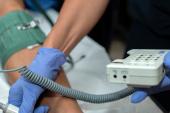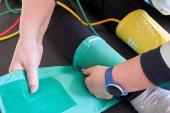No Sex-Specific Differences in PAD Therapy Outcomes: REVIVE Analysis
The data support endovascular therapy with stent implantation as an alternative to bypass surgery in men and women.

LONG BEACH, CA—Women with symptomatic PAD have procedural and safety outcomes that are as good as those of men when undergoing endovascular therapy and stent implantation versus vascular bypass surgery, according to a sex-specific subanalysis of the REVIVE trial.
Serdar Farhan, MD (Icahn School of Medicine at Mount Sinai, New York, NY), who presented the results in a featured clinical research session here at SCAI 2024, said the data are useful given that the optimal revascularization strategy in women remains unknown, and treatment recommendations have been mainly based on data from male-dominated clinical trials.
The subanalysis also showed that at 2 years, endovascular therapy was associated with shorter hospital stays and fewer complications compared with surgery.
“This pooled analysis of individual patient data further supports the efficacy and safety of endovascular therapy with stent implantation as an alternative to bypass surgery in women and men,” Farhan noted in his presentation.
“This is a really interesting and important identification that the sex differences really aren't there, [because] I think we think sometimes they might be,” said panelist S. Elissa Altin, MD (Yale School of Medicine, New Haven, CT).
However, she pointed out that the Vascular Quality Initiative (VQI) and other sources indicate that women with PAD have higher rates of aortoiliac disease compared with men and tend to present later than men for a host of reasons that are often more related to the responsibilities of being female rather than to their disease, and those differences can contribute to worse long-term prognosis.
“I think what you're identifying is that in a clean cohort of claudicants, men and women have similar outcomes, and that's great,” she said. “In a lot of other studies, we see that once you take out the risk factors, [then] all people, all colors, all flavors have similar outcomes. But it's the comorbid risk factors that make the difference, so it's a very cohesive story.”
REVIVE Subanalysis Results
The main REVIVE study pooled patient-level data from five RCTs investigating endovascular therapy with stent implantation versus bypass surgery with either a prosthetic or autologous vein graft.
Among the 639 patients (mean age 68 years; 29% women), 325 underwent endovascular therapy (104 women and 221 men) and 314 had bypass surgery (81 women and 233 men).
Most baseline procedural characteristics were similar between men and women across treatment groups, with more than 60% having a TASC D femoropopliteal lesion. Concomitant revascularization of the common femoral artery occurred with higher frequency in both men and women who underwent surgery compared with endovascular therapy, but the difference was only statistically significant in men (17.2% vs 6.8%; P < 0.001). Technical failure occurred only in the endovascular arms, with rates of 2.9% in women and 9% in men.
At 2 years, the rate of major adverse limb events (MALE) in the female cohort was 40.6% for endovascular therapy and 42.1% for surgery (P = 0.764), and in the male cohort it was 39.7% and 34.4%, respectively (P = 0.963).
There were no sex differences in either treatment group for the secondary endpoint of amputation-free survival or for the individual endpoints of all-cause death, major amputation, reintervention of the target limb, and loss of primary patency.
Compared with surgery, rates of the composite endpoint of bleeding, infection, or death at 30 days were lower with endovascular therapy in both women (8.7% vs 25.96%; P = 0.002) and men (5.9% vs 21.5%; P < 0.001). Hospital stays for women averaged 7.2 days in the surgery group and 3.7 days in the endovascular group (P < 0.001) and for men they averaged 7.4 days and 2.8 days, respectively (P < 0.001).
To TCTMD, Farhan said the next step in the research is to model cost differences, which is difficult to do with pooled data from multiple studies, “but we can extrapolate it to the current era and maybe come up with another analysis.”
He added that the role of medical therapy and its potential to improve event rates needs more introspection based on what this and other analyses consistently show regarding PAD treatment challenges.
“When we talk to our patients, [we can] say that almost every second patient will come back to us within 2 years with all the best efforts, regardless of bypass surgery or endovascular treatment,” Farhan noted. With newer drugs and newer technologies, there is reason for optimism that those event rates can be lowered, he concluded.
L.A. McKeown is a Senior Medical Journalist for TCTMD, the Section Editor of CV Team Forum, and Senior Medical…
Read Full BioSources
Farhan S. Sex differences in outcomes by revascularization strategy in peripheral arterial disease involving the femoropopliteal segment: a pooled analysis of individual patient data. Presented at: SCAI 2024. May 3, 2024. Long Beach, CA.
Disclosures
- Farhan reports no relevant conflicts of interest.





Comments